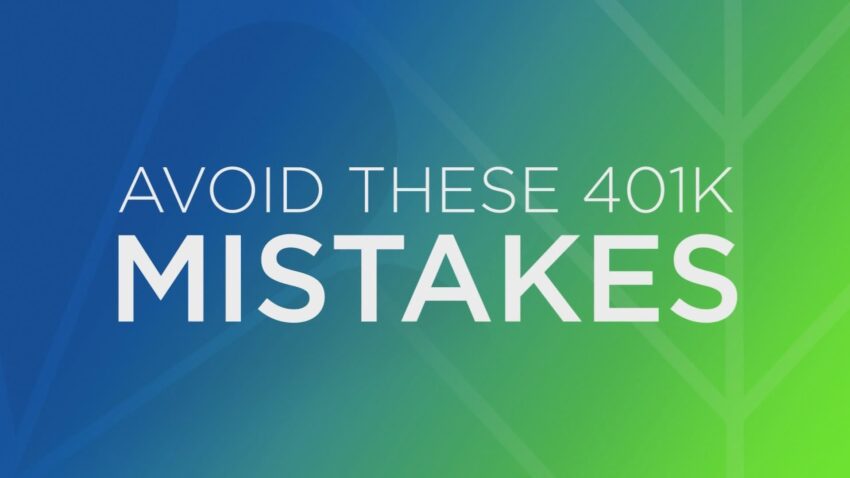Your retirement is a significant chapter in your life. It’s a time for relaxation, adventure, and pursuing your passions. However, to enjoy this chapter to the fullest, you need a solid financial plan. A 401(k) plan can be your ticket to a comfortable retirement, but it’s important to navigate it wisely. In this article, we’ll explore some of the most common 401(k) mistakes and provide valuable insights on how to avoid them to secure your financial future.
Common 401(k) Mistakes
- Inadequate ContributionsIt’s surprising how many people don’t contribute enough to maximize their retirement savings. Your employer’s matching contributions are essentially free money. Not contributing enough means leaving this free money on the table. To avoid this mistake, commit to contributing at least enough to receive the full employer match. Consider this your retirement foundation and gradually increase your contributions over time as your financial situation improves.
- Lack of DiversificationDiversification is your shield against financial storms. Relying too heavily on a single asset, like your company’s stock, exposes your savings to unnecessary risk. To mitigate this mistake, diversify your portfolio across different asset classes, such as stocks, bonds, and cash. Diversification spreads risk and can lead to more stable, long-term returns. Consider your risk tolerance and financial goals when determining your asset allocation.
- Ignoring Investment FeesInvestment fees may seem minor, but they can eat into your retirement savings over time. To avoid this mistake, choose low-cost investment options and be aware of expense ratios and administrative fees. Opt for low-cost index funds or exchange-traded funds (ETFs) to keep fees in check. High fees can significantly erode your long-term returns, so it’s worth the effort to minimize them.
- Failure to RebalanceOver time, the allocation of your investments within your 401(k) can shift, deviating from your desired asset allocation. Failing to periodically rebalance your portfolio can lead to an unbalanced investment strategy. To prevent this mistake, review your investments regularly and adjust your portfolio to maintain your desired asset allocation. Rebalancing involves selling investments that have done well and buying those that have underperformed, effectively resetting your portfolio to your target allocation. It’s a key strategy for managing risk in your retirement investments.
- Early WithdrawalsWithdrawing money from your 401(k) before reaching retirement age is a costly mistake. Early withdrawals can result in penalties, taxes, and a loss of long-term growth potential. Leave your 401(k) funds untouched until you reach retirement age. Consider alternative options like a rollover when changing jobs. A rollover allows you to transfer your 401(k) funds into an IRA or your new employer’s plan without incurring penalties or taxes, preserving the tax-advantaged status of your savings.
Avoiding 401(k) Mistakes
Now that we’ve highlighted common 401(k) mistakes, let’s discuss how to avoid them and make the most of your retirement savings:
- Contribution Strategies
- Contribute at least enough to receive the full employer match, as it’s essentially free money.
- Gradually increase your contributions over time as your financial situation improves. A good rule of thumb is to increase your contributions every time you receive a raise or a windfall like a bonus.
- Diversification Tips
- Understand the concept of asset allocation and ensure your investments are spread across different asset classes.
- Diversify your portfolio to include a mix of stocks, bonds, and cash to spread risk and potentially improve your long-term returns. Consider periodically rebalancing your portfolio to maintain your desired asset allocation.
- Fee Management
- Choose low-cost investment options, such as index funds or ETFs.
- Be vigilant about expense ratios and administrative fees. By keeping your fees low, you can maximize the growth of your retirement savings.
- Regular Rebalancing
- Establish a schedule for reviewing and rebalancing your portfolio, whether it’s annually, semi-annually, or when your allocation deviates significantly from your target.
- Consider seeking professional advice or using automated robo-advisors to ensure your asset allocation aligns with your financial goals.
- Retirement Age Withdrawals
- Leave your 401(k) funds untouched until you reach retirement age to maximize your savings. The longer your money remains invested, the more it can benefit from the power of compounding.
- When changing jobs, consider rolling over your 401(k) into your new employer’s plan or an individual retirement account (IRA) to maintain tax advantages. A direct rollover ensures a smooth transition of your savings without triggering taxes or penalties.
Conclusion
By avoiding these common pitfalls and making wise decisions, you can look forward to a financially secure retirement. Your 401(k) is a valuable tool for building a secure financial future, and making the right choices along the way is essential to realizing your retirement goals. Start today by assessing your 401(k) strategy and taking steps to secure a comfortable retirement. Your future self will thank you for it, and you’ll be better prepared to embrace the retirement you’ve always envisioned.

